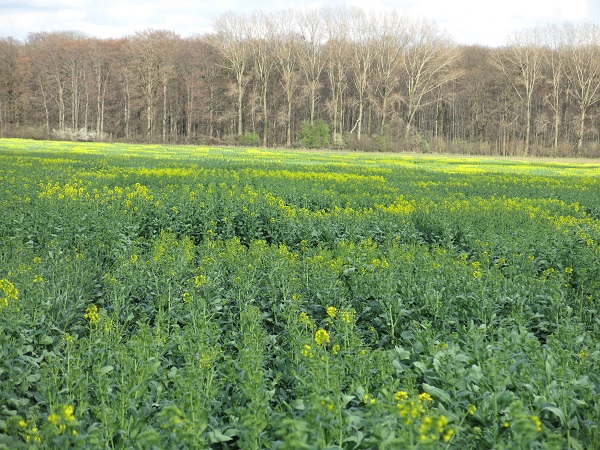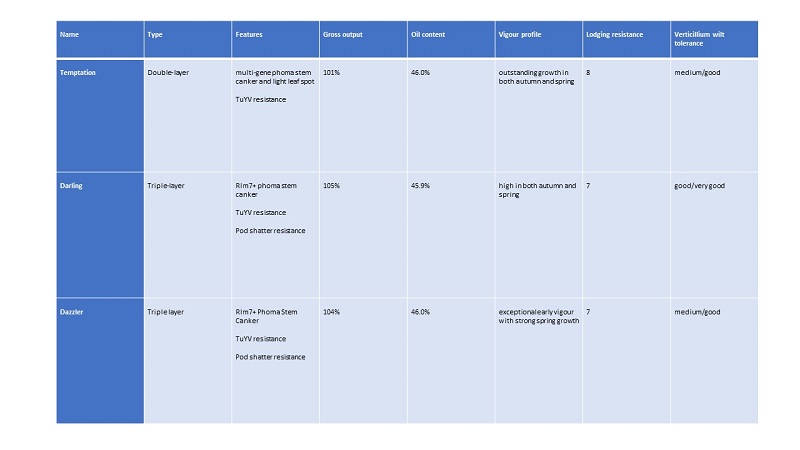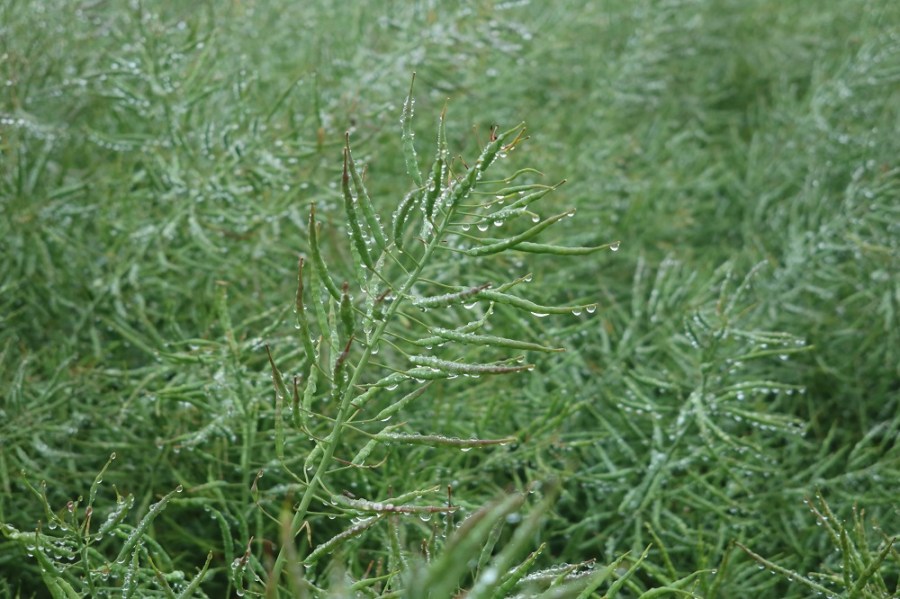 As one of the leading breeders of recent years, DSV has been a pioneer of high- performance hybrid oilseed rape with the development of their new ‘layered’ varieties, featuring optimum combinations of disease resistance and beneficial physical properties, now accelerating as demands for ‘drill and forget’ cropping grows.
As one of the leading breeders of recent years, DSV has been a pioneer of high- performance hybrid oilseed rape with the development of their new ‘layered’ varieties, featuring optimum combinations of disease resistance and beneficial physical properties, now accelerating as demands for ‘drill and forget’ cropping grows.
Genetics are coming to the fore in oilseed rape breeding. CPM talks to breeders DSV to discover the traits hybrid varieties now offer and how these are useful to growers as the crop faces new challenges.
Strong spring vigour, is at least as important as autumn vigour.
By Lucy de la Pasture
Hybrid oilseed rape varieties initially gained popularity with UK growers because of their improved vigour over conventional varieties, which in the field led to greater establishment reliability and higher yields.
As the regulatory climate has changed and pesticide resistance has become commonplace, growers have looked more and more to plant breeders to provide genetic solutions to agronomic problems to reduce their reliance on pesticides. This is where hybrids have the distinct advantage because new traits can be introduced in a fraction of the time it takes using the ‘trial and error’ approach of conventional breeding.
Dr Alexander Dӧring, international OSR product manager at plant breeder DSV, explains the progress made in hybrid breeding and Mike Mann, managing director of DSV UK highlights, how these combinations of traits will benefit OSR producers.

Hybrids allows plant breeders to incorporate traits much more quickly than in open-pollinated varieties.
What traits are available in OSR
Modern hybrids have come a long way from the tall, high yielding varieties that were first introduced several decades ago. Difficulties in establishment and variabilities in OSR yield have always been two of the main drivers in plant breeding but losses in the armoury of plant protection products and resistance have become increasingly influential.
Recognising this, DSV introduced key characteristics into all their new hybrid OSR varieties to ensure they were well equipped for the post-neonicotinoid (PNN) era. The characteristics identified to give PNN varieties the edge are a superior primary response (vigour in the first 40 days), enhanced solar capture, performance stability and optimum pod presentation.
With these four characteristics as a foundation, varieties are now being produced with other genetic traits ‘layered’ on top. As new varieties are coming through the number of layers is becoming more complex, with the first quad-layered varieties soon to reach the market.
Some of the key traits currently available to plant breeders are resistance to phoma stem canker and light leaf spot, TuYV resistance, tolerance to verticillium wilt, pod shatter resistance, club root resistance and ALS-tolerance in Clearfield varieties.
Why are they important?
OSR has historically had a relatively high need for fertilisers and crop protection products but, since the introduction of a hazard-based approval process in the EU, products are being lost at a faster rate than new chemistry can replace them.
A diminishing pool of crop protection products has come at a time when resistance too has limited effective control of important pests, such as cabbage stem flea beetle and the aphid virus vector Myzus persicae which is responsible for spreading the disease, turnip yellows virus (TuYV).
A changing climate is an added pressure, with light leaf spot becoming problematic throughout the UK where it was once a disease confined to the North. Its polycyclic life cycle has put pressure on the triazole chemistry used to control it and there’s evidence that fungicide resistance in now present within the pathogen population.
For a crop where obtaining yield reliability under UK conditions has always been a challenge, growing OSR successfully and profitably hasn’t become any easier in the past decade.
This is where hybrid breeding to introduce disease resistance and agronomic traits to limit the reliance on pesticides to tackle these problems has really come of age.
What is ‘Triple Layer’ protection?
All DSV varieties have the PNN growth characteristics and the first layer to be added was a multi-gene resistance for phoma stem canker and light leaf spot, with Dariot the first DSV variety to offer single-layer PNN.
Any trait can be added to offer a double-layer PNN variety such as DSV Temptation, which features resistance to phoma stem canker and light leaf spot combined with TuYV resistance.
DSV Darling and Dazzler are both candidates on the AHDB’s 2019-20 candidate list and are triple-layer varieties, with TuYV and pod shatter resistance stacked with multi-gene resistance to phoma and light leaf spot. These varieties herald the dawn of a new generation of OSR hybrids which combine traits to support dependable high yields with lower inputs, making them suitable for integrated pest management approaches.
Are additional layers available?
In the very near future quad-layer varieties will be a very real prospect and are expected to become commercially available in 2020. These will have verticillium wilt tolerance and clubroot resistance added to the mix and there are currently two new quad-layered varieties now entering the UK testing system.
The first is a high output hybrid OSR, featuring multi-gene phoma stem canker, TuYV, pod shatter and clubroot resistances.
With clubroot an increasing problem in the Borders and Scotland this will be a variety particularly relevant to the North of the country, although it is clear that the disease is becoming an issue in other parts of the UK.
What about Clearfield?
A similar approach to breeding is being taken in the Clearfield programme, with additional traits being stacked in new varieties.
Phoenix CL is the first DSV Clearfield variety to include pod shatter resistance and new variety, Plurax CL, takes this a step further featuring a strong tolerance to verticillium wilt as an additional layer.
The second quad-layered variety just entering the trials system is a Clearfield variety which features phoma stem canker resistance together with TuYV and pod shatter resistance. This will sit well alongside the other layered varieties in the Clearfield portfolio and the incorporation of TuYV resistance will reduce dependency on insecticides to control the vector of what is becoming a significant disease in the UK.
How do these varieties perform?

FOOTER Source: Data on Temptation from AHDB 2019/20 Recommended List and on Darling and Dazzler from AHDB 2019/20 Candidate List
How do you get the best from them?
Darling has been noted for its strong spring vigour, which is at least as important as autumn vigour when considering damage from cabbage stem flea beetle (CSFB) larvae. Trials evidence shows that OSR hybrids that are faster to develop before winter and the start of stem elongation can markedly limit the damage from larvae.
Darling’s high spring vigour means it can often benefit from a PGR application to ensure the canopy is optimised and well branched.
Dazzler is one of the fastest growing autumn varieties available, a characteristic which can mitigate the effects of adult CSFB damage as it can quickly grow new leaves. But it also gets away quickly in the spring where it’s among the earliest varieties to flower.
Both are triple-layer varieties which have TuYV resistance and this protects the plant throughout its lifecycle. Plants with high levels of TuYv infection find it much more difficult to deal with ‘stress’ – for example high levels of larvae damage.
Dazzler’s good standing power means it can tolerate higher seed rates, though may require a spring PGR if higher populations come through the winter. The added benefit of pod shatter resistance provides protection against summer storms and delayed harvesting.
Double-layered variety, Temptation, offers flexibility, versatility and outright vigour, meaning growers can choose the best drilling date for their situation. It shows good early vigour but without the tendency to overgrow and exhibits strong compensatory growth.
A key characteristic of Temptation is its strong, dark blue leaves that help fill the pods and produce seed with high TGW together with a good oil content and gross output.
OSR agronomic traits: top tips:
- Make good use of traits – selecting a hybrid variety with layered traits can help ease management and reduce costs.
- Reduce reliance on insecticides – hybrids with inbuilt TuYV resistance means an insecticide isn’t needed to control its aphid vector, allowing predators to build up.
- Harness hybrid vigour – vigorous growth in the autumn and in spring gives the crop the best chance of growing away from CSFB damage.
Layered genetics help save costs and ease management
With 950ha of OSR in the ground, the opportunity to cut inputs and achieve greater consistency of production has real appeal to Lincs grower, Andrew Harker of H. R. Bourn and Sons.
He’s currently growing double-layer variety Temptation, which he reports is looking good, and in the autumn Andrew plans to add the triple-layer variety Darling into the mix.
When it comes to OSR, establishment is key, he believes, so the high early vigour at the heart of the new layered varieties is important to him.
“Our land is spread across 40 miles and we’ve got a real range of soil types within that – from light, sandy soil to heavy clay and everything in between. It means the varieties we choose have to establish reliably in a range of conditions.
“Flea beetle is an issue here but the lack of water after drilling was a bigger problem last year. Slugs can be an issue as well, so we want something that has the vigour to get growing right away and the strength to keep going to fend off disease and pest threats,” comments Andrew.
“Spring vigour is also important, so we get good canopy development and pod fill as the season develops.”
Genetic resilience is becoming increasingly significant now varieties have to cope with a wider range of growing conditions than ever before, Andrew believes.
“This year we were able to start our spring drilling in Feb, whereas last year it wasn’t until April because it was so cold. We also seem to have more ‘blocks’ of very different weather, so you have to make full use of available windows. This can make timings of applications difficult as well as testing a variety’s ability to cope with different stresses.
“So as well as cost-savings from reduced inputs, layered varieties should make day-to-day management easier,” he adds.
Pod shatter resistance as part of the layered approach has real benefits, he believes.
“With such a large area to harvest, pod shatter resistance is a good insurance policy for us. We really don’t want to lose any yield through shedding before we can harvest the crop.”
In terms of disease control, Andrew views the stem canker and light leaf spot resistances in the triple-layered varieties as welcome, but he believes the TuYV element is probably even more important.
“TuYV seems to be one of those hidden diseases that you don’t really see but it’s there in the background, just nipping away at your yields without you knowing about it. It’s another key insurance policy which I think will become even more important in the future.
“We’re all going to have reduce our dependence on chemistry not just because of product revocations and environmental considerations, but because we have to move to lower cost methods of production and the layering approach makes perfect sense to me.”
“It’s always tempting to say we should save a bit of conventional seed and see if it germinates before spending any money on it. But in reality, we have to grow better varieties, with higher performance potential and the in-built reliability needed to address the challenges growers now face.”
Sponsor message
DSV’s new layered varieties are a great example of how the requirements of growers, the opportunities offered by advanced technology and the vision of forward-looking companies can align themselves to respond to the challenges posed by modern agriculture and the environment in which it operates.
The way we farm is changing and fast. Whether it’s revocation of chemistry, impact of climate change, environmental considerations or the best way to protect our soils, everything is up for debate.
In such a future the key words of resilience and reliability become increasingly important as these give growers greater security and safety in terms of their overall production and business viability.
The opportunity to grow strong healthy crops, less reliant on inputs and management intervention is a real game-changer for crop producers and this is precisely why high performance ‘layered’ varieties will become increasingly important in the challenging future we all face.




